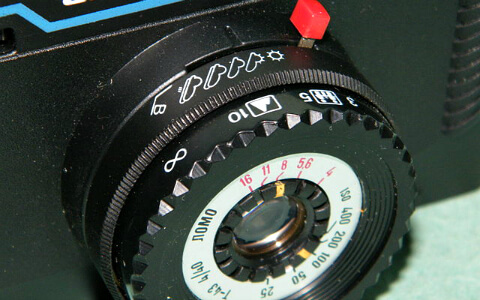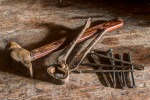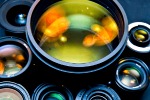The sunny 16 rule, or: Manual exposure for everyone (really)
The sunny 16 rule is a simple rule of thumb letting you expose manually in most lighting conditions. In its basic form, it's the simplicity itself. In sunny weather, set the aperture to f/16 and the shutter speed to the reciprocal ISO value, that is, 1 divided by ISO, in seconds. This is it!
You may want to rotate your phone in order to improve your browsing experience on this site.

If it is sunny where you are reading this (lucky you), stop now, go outside, and take some pictures to test it, but be sure to return and continue!
A long history
Ever wondered why your camera sometimes (often) settles for exposing at f/9.3 and 1/560 s and not, say, f/8 and 1/750 s?
Well, the most probable answer is, it doesn't care! It makes absolutely no difference to the camera or its software, all numbers are equally meaningful – or meaningless – to it. It is us, humans, who feel irritated by off values.
The whole has a history. For a very long time, cameras were not sophisticated enough, or at all, and relied for quite everything on the person behind the viewfinder, exposure included. It was during this time when the sunny 16 rule formed to aid that very person.
The rule provided a useful method for calculating exposure in most daylight situations and without any technical help. Surprisingly, it holds to this day, even if not being in high demand, with digital and automatic all around.
If you think about it, the rule is especially useful for landscape photography and digital cameras. If nothing else, it provides a good starting point in quest for the ideal exposure, just like your camera's automatic output does. With landscape as your subject, you can afford enough time to assess the results and adjust your settings as needed.
The whole story
Back to the sunny 16 rule itself!
What it is telling is this: If you load your camera with an ISO 100 film – or set it to ISO 100 – the correct exposure on a sunny day will be achieved at f/16 and around 1/125 s.
Many old cameras would only allow preset aperture and shutter speed values, with 1/125 s being one of them.
Of course, you don't have to follow it literally. Use f/8 and 1/500 s. Or f/22 and 1/60 s. Or, up ISO to 200 and use f/5.6 at 1/2000 s.
Verify that all examples above result in the same exposure value! Check the answers near the end if in doubt.
The rule changes depending on the available light, but the changes are easy to follow. As you would expect, the less light is available, the larger aperture, or the smaller f-number is to select.
In general, for the correct exposure, set the aperture according to the table below, while keeping the shutter speed close to 1/ISO in seconds:
|
Weather/Lighting |
Shadows |
Aperture to choose |
|
Sunny with sand/snow in the background |
Dark with sharp edges |
f/22 |
|
Sunny |
Distinct |
f/16 |
|
Light clouds |
Soft around edges |
f/11 |
|
Overcast |
Barely visible |
f/8 |
|
Heavy clouds |
No shadows |
f/5.6 |
|
Storm clouds, open shade, sunset |
No shadows |
f/4 |
In the opening image of a Russian Smena-35 film camera, the weather symbols account for setting the shutter speed. The selected "light clouds" option sets the camera to 1/125 s. The aperture is coupled to ISO, with ISO 100 resulting in f/8 as shown.
Comparing this with our rule, it would seem that the camera tended to overexpose by 1 EV. However, consider that ISO values were assigned to existing films actually produced with ASA graduation – ISO 100 relating in fact to a 65 ASA film – and you get a perfect following to the sunny 16 rule. (You sure can prove everything above, can't you? The answers are near the end.)
While this might look like juggling with numbers, the example can also highlight how tolerant the photographic film was as a medium, or, actually, still is.
In fact, this is true for sensors as well. Seemingly, we got obsessed with numbers when they actually don't matter that much. In many cases, our eyes wouldn't even notice a difference in exposure which the numbers coming out of our cameras suggest.
The sunny 16 rule went to become the basis for many an exposure guide, as seen on the back plate of the Swiss Tessina camera from the 60s:
 Exposure guide based on the sunny 16 rule
Exposure guide based on the sunny 16 ruleImage by Gisling, via Wikimedia Commons
If you have difficulties following this guide, it suggests aperture settings for different film speeds and lighting conditions to use with the exposure time of 1/125 s. DIN is a logarithmic scale still in use today. DIN 21° corresponds to modern ISO 100. ASA was a linear scale similar to ISO. It was introduced in the 40s by the American Standards Association and revised several times before its withdrawal in the mid-80s.
Applying the rule
If your camera allows for manual exposure, follow these simple steps to try the sunny 16 rule by yourself:
- Set your camera to manual mode: select M on the mode wheel. If you used to think of it as a Monster or Magic feat, it's time to think again and see it as your Master degree instead!
- Choose the ISO: your camera's lowest possible value is a good start
- Select the aperture from the table above: e.g., f/11 in a slightly overcast weather. Calculate the shutter speed based on your chosen ISO. Adjust if needed
- Go! Take some shots, assess the results, see if they need some tweaking, try another ISO setting, experiment...
- Be creative, be free!
Answers to the exercises
- Let's sum up changes in exposure value resulting from different settings:
- +2 EV for aperture -2 EV for shutter speed = 0
- -1 EV for aperture +1 EV for shutter speed = 0
- +1 EV for ISO +3 EV for aperture -4 EV for shutter speed = 0
- Using the same approach:
- According to the rule, the correct exposure should be achieved with f/11 @ 1/125 s. f/8 @ 1/125 s would result in +1 EV
- For a film graded at 65, the rule suggests using f/11 @ 1/60 s. This is consistent with f/8 @ 1/125 s proposed by the camera, which means +1 EV for aperture -1 EV for shutter speed = 0
Tags: #sunny16 #manualexposure #cameraexposure
Other articles on camera exposure
- Aperture and depth of field
- Learn what aperture is, and how its different settings can change the look of your images.
- Shutter speed and motion blur
- Learn how exposure time can add dynamic and movement to your images.
- ISO and digital noise
- Learn how photo noise is related to your chosen ISO value.
- Metering modes
- Understand different metering modes and when to use them.
- Exposure compensation and bracketing
- Learn how to overcome shortcomings of your camera's automatic exposure metering.
- The sunny 16 rule and manual exposure
- Measure up to your camera and take exposure in your own hands with this simple and easy to follow rule.
Tell me what you think!
Is it useful 👍? Awful 👎? Leave a message! Your comments help make this site better (and give me a kick—one way or another).
Popular articles
-
A kind of magic
If a digital picture has to be seen in the real world, printed on a real medium and displayed in a real showcase, its transition from RAW to real is better done in an old school image editor. Enter A…
-
A duck for a dog
If you got your own place on the Internet, helping your visitors find what they are looking for is a great way to engage them and keep them staying a bit longer. A custom site search can achieve just …
-
"Might as well have the best"
Aiming for better images? Think better lenses! This is your most important piece of gear, so you better get it sorted out. — Need some advice?
 Become a patron for
Become a patron for